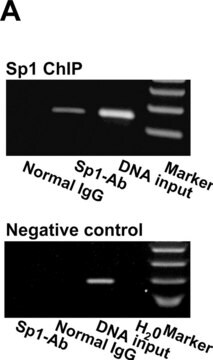09-482
Anti-PI3 Kinase Antibody, p110β
from rabbit, purified by affinity chromatography
Synonym(s):
PI3-kinase p110 subunit alpha, phosphatidylinositol 3-kinase, catalytic, 110-KD, alpha, PtdIns-3-kinase p110, phosphatidylinositol 3-kinase, catalytic, alpha polypeptide, phosphatidylinositol-4,5-bisphosphate 3-kinase catalytic subunit, alpha isoform, ph
About This Item
Recommended Products
biological source
rabbit
Quality Level
antibody form
affinity isolated antibody
antibody product type
primary antibodies
clone
polyclonal
purified by
affinity chromatography
species reactivity
human, canine
species reactivity (predicted by homology)
rat (immunogen homology), mouse (immunogen homology), dog (immunogen homology), monkey (immunogen homology)
technique(s)
ELISA: suitable
immunocytochemistry: suitable
immunohistochemistry: suitable
immunoprecipitation (IP): suitable
western blot: suitable
NCBI accession no.
UniProt accession no.
shipped in
wet ice
target post-translational modification
unmodified
Gene Information
human ... PIK3CB(5291)
General description
Specificity
Immunogen
Application
This antibody was tested and determined to work for ELISA at 0.5 ng/well.
Signaling
PI3K, Akt, & mTOR Signaling
Quality
Western Blot Analysis: 0.05 - 0.1 μg/mL of this antibody detected endogenous PI3 Kinase, p110β in lysate from HEK-293 cells.
Target description
Linkage
Physical form
Storage and Stability
Handling Recommendations: Upon receipt, and prior to removing the cap, centrifuge the vial and gently mix the solution.
Analysis Note
HEK-293 cell lysate.
Other Notes
Disclaimer
Not finding the right product?
Try our Product Selector Tool.
Storage Class Code
12 - Non Combustible Liquids
WGK
WGK 1
Flash Point(F)
Not applicable
Flash Point(C)
Not applicable
Certificates of Analysis (COA)
Search for Certificates of Analysis (COA) by entering the products Lot/Batch Number. Lot and Batch Numbers can be found on a product’s label following the words ‘Lot’ or ‘Batch’.
Already Own This Product?
Find documentation for the products that you have recently purchased in the Document Library.
Our team of scientists has experience in all areas of research including Life Science, Material Science, Chemical Synthesis, Chromatography, Analytical and many others.
Contact Technical Service








